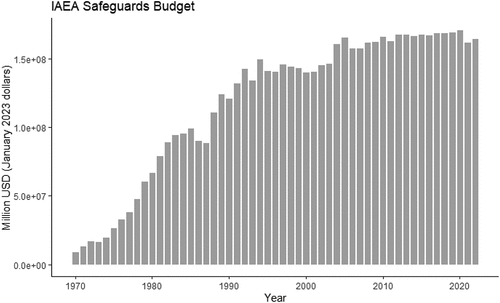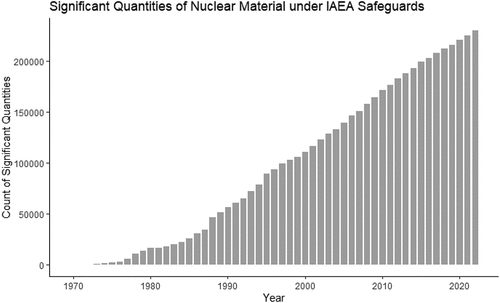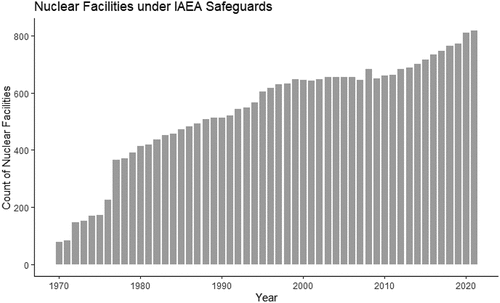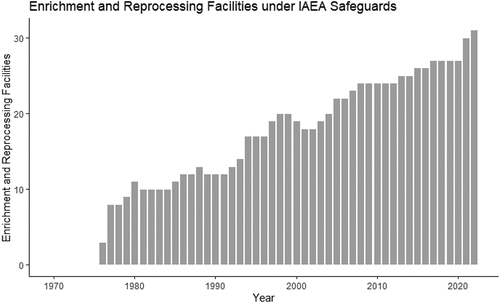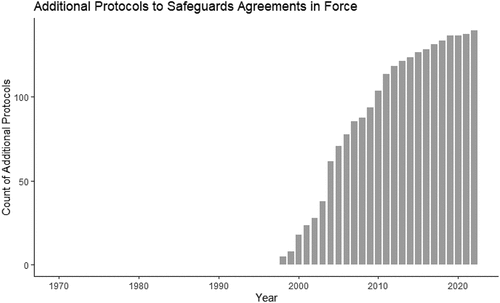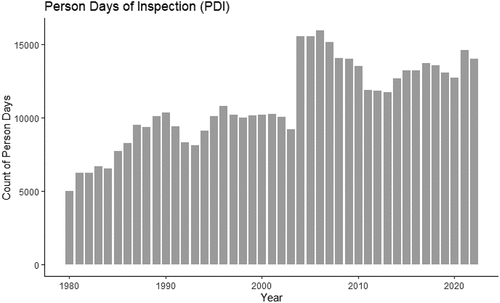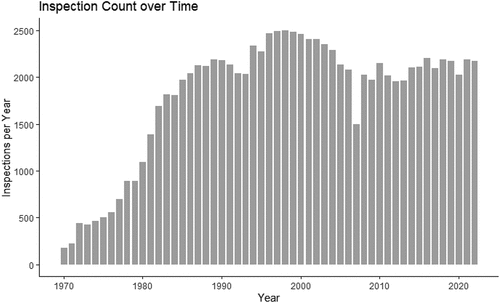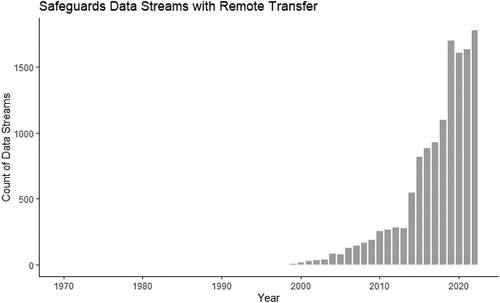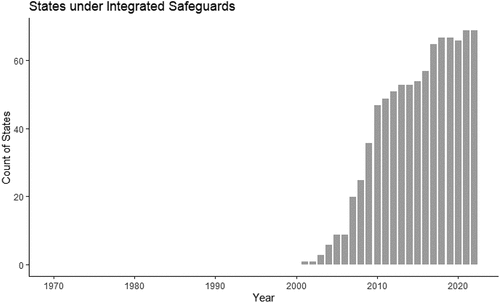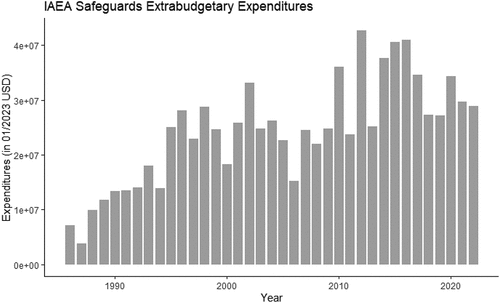ABSTRACT
The scope and breadth of nuclear safeguards activities are expanding as new nuclear facilities begin operations and countries sign new or extended safeguards agreements. The International Atomic Energy Agency (IAEA) has adopted technical and policy innovations to meet these increasing safeguards demands within their constrained resources. This study analyzes prominent safeguards innovations to determine their impact on safeguards inspection effort, measured in person-days of inspection. The most significant impact on inspection effort resulted from optimized safeguards measures called Integrated Safeguards, which are implemented in states for which the IAEA has concluded that all nuclear materials remain in peaceful uses (known as the “broader conclusion”). The impact of Integrated Safeguards on inspection effort could justify striving for broader conclusions for more states.
Introduction
The International Atomic Energy Agency (IAEA) is responsible for monitoring global nuclear energy programs to detect if materials or facilities in civilian nuclear programs are diverted or misused to develop nuclear weapons. The IAEA’s verification of peaceful nuclear programs provides transparency and confidence that promotes the non-proliferation of nuclear weapons. The IAEA’s ability to complete its verification mandate therefore has consequences for global security. As states continue to use nuclear energy, expand their nuclear energy programs, develop novel nuclear facility designs, or start using nuclear energy for the first time, the IAEA’s safeguards inspection effort is increasing. Given the organization’s constrained verification resources, the IAEA must increase efficiency through the adoption of innovative policies and technologies. This paper interrogates prominent safeguards innovations to determine their impact on safeguards efficiency.
First, this paper introduces the IAEA, its nuclear safeguards mission, and the safeguards budgetary context. Second, it identifies multiple factors demanding increasing safeguards resources within that limited budget. These factors include increases in significant quantities of nuclear material, the number of nuclear facilities, the complexity of nuclear facilities, and the more expansive and resource-intensive safeguards agreements. Third, the paper describes safeguards innovations adopted by the IAEA to counter its increasing workload. The analysis focuses specifically on three innovations that have been most broadly covered in the literature: Integrated Safeguards, Remote Data Transfer, and Extrabudgetary Expenditures from contributions by member state support programs. Finally, this paper uses linear regression to evaluate the impact of the three safeguards innovations on safeguards efficiency metrics, using data from open-source IAEA Annual Reports and annual IAEA Safeguards Statements. The paper concludes with policy recommendations and proposals for future work.
The International Atomic Energy Agency
The IAEA was established in 1957 under the auspices of the United Nations. The IAEA was created to serve two complementary roles: to promote the peaceful use of nuclear technologies and to verify that nuclear technologies and materials were not being misused to develop nuclear weapons activities. In its verification role, the focus of this research, the IAEA implements technical measures called nuclear safeguards to verify that states are not diverting nuclear materials, misusing nuclear facilities, or engaging in other undeclared nuclear activities. As of September 2023, the IAEA had a total of 178 member states (International Atomic Energy Agency, Citation2023a).
International Nuclear Safeguards
International nuclear safeguards agreements are agreements between states (or regions) and the IAEA. Under safeguards agreements, the IAEA implements a set of technical measures to enable its verification that states are not misusing their civilian nuclear energy programs to develop nuclear weapons. There are a broad range of measures that can be applied depending on the nuclear facility type and the safeguards agreement. The safeguards essential activities are verification of inventory, and inventory changes, of the operator’s material accountancy. Safeguards measures can include, for example: destructive and non-destructive assay of nuclear materials to confirm quantity and isotopic content; verification of the design and use of a nuclear facility; and the application of containment and surveillance technologies to maintain continuity of knowledge over equipment, areas, or containers. Important safeguards activities also take place at IAEA Headquarters, including statistical analyses, open-source information analysis, and laboratory analyses of materials collected in the field.
Most states have safeguards agreements with the IAEA based on their signature of the Treaty of the Non-Proliferation of Nuclear Weapons (known as the Nonproliferation Treaty, or NPT), which requires safeguards agreements with the IAEA under Article III of the treaty (Treaty on the Non-Proliferation of Nucear Weapons Citation1970). In the early 1970s, immediately following many states’ signature of the NPT, the IAEA was responsible for implementing nuclear safeguards measures in a significantly increased number of states. The IAEA uses a template for these safeguards agreements under the Nonproliferation Treaty, published under Information Circular 153 (International Atomic Energy Agency Citation1972). The safeguards implemented under this type of agreement are generally referred to as comprehensive safeguards.
After revelations of undeclared nuclear activities in Iraq and the Democratic People’s Republic of Korea in the early 1990s, it was apparent that the IAEA needed additional tools to detect undeclared nuclear activities. The IAEA established a working group to clarify perceived gaps in safeguards coverage. Some of the measures identified by the working group could be utilized immediately (called Part I measures), while others required new legal authority (Part II measures). The clarifying language and extended legal authority required for Part II measures were codified in a document known as the Model Additional Protocol (International Atomic Energy Agency Citation1997b). For states that signed an Additional Protocol, a broader portion of the nuclear fuel cycle was under safeguards obligations and required additional reporting on activities like imports and exports, research and development activities, uranium mining and milling, and nuclear energy plans (International Atomic Energy Agency Citation1997b).
The IAEA Safeguards Resource Environment
The IAEA budget has three components: the regular budget (the focus of this section), extrabudgetary contributions (voluntary contributions by Member States, described more in the Safeguards Innovations section), and technical cooperation funds (for technology transfers and support). The regular budget and extrabudgetary contributions for safeguards are most relevant for this research, though it should be noted that there is a norm to balance the regular budget for safeguards verification activities with contributions made to technical cooperation programs as part of the IAEA’s dual roles to promote and monitor nuclear technologies (Kessler Citation1989; Shea Citation2008). To finance the regular budget, the Board of Governors assigns amounts for Member States to contribute based on a scale fixed by the United Nations (International Atomic Energy Agency Citation1989, p. Art XIV D).
In the 1970s, the IAEA experienced rapid growth due to safeguards agreements required under the NPT. This growth prompted concern among Member States that the IAEA could become too large (Kessler Citation1989). In 1985, a group of the United Nations largest contributors called the Geneva Group recommended a zero real growth budget, requiring budget increases only to meet the inflation rate. The intent was to limit IAEA growth and promote fiscal efficiency (Redden Citation2003).
The IAEA budget has increased beyond inflation levels several times since 1985 in reaction to specific events such as the Chernobyl nuclear accident (ElBaradei Citation2008), but has largely stabilized as shown in .
Increasing Demands for IAEA Safeguards Resources
Despite their relatively flat budget, the IAEA Department of Safeguard faces increasing demands on their resources. The drivers for additional safeguards resources relate to both the expansion of nuclear technologies and the increase of safeguards verification scope. Some of the most recognized measures of increasing demand for safeguards resources include the global increase in significant quantities of nuclear material, the increasing number of nuclear facilities under IAEA safeguards, the growing complexity or difficulty to safeguard nuclear facilities, and increasing scope of safeguards agreements. Each of these drivers for increased safeguards effort are described below.
Significant Quantities of Nuclear Material
One factor in the growing IAEA safeguards workload is the increasing significant quantities of nuclear material under safeguards. Significant quantity is a metric used by the IAEA, defined as the “approximate amount of nuclear material for which the possibility of manufacturing a nuclear explosive device cannot be excluded” (International Atomic Energy Agency Citation2022b, p. 30). Significant quantities reflect both quality (attractiveness for weapons) and quantity (kilograms or metrics tonnes) of material as shown in (International Atomic Energy Agency Citation2022b). They inform the IAEA’s timeliness goals for diversion detection, which in turn define the frequency of on-site inspections. Increasing significant quantities result from the continuous use of nuclear energy in states with established nuclear programs, and new nuclear states producing and processing nuclear materials. Significant quantities of nuclear material under safeguards are shown in .
Table 1. IAEA definition of significant quantities of nuclear material (International Atomic Energy Agency, Citation2022b, p. 31).
Significant quantities do not represent a constant level of safeguards effort. For example, one significant quantity of plutonium in spent nuclear fuel (8 kilograms, containing less than 80% of the isotope plutonium-239) requires detection of diversion within three months (International Atomic Energy Agency Citation2022b). Alternatively, one significant quantity of natural uranium (10 t) has a detection timeliness goal of one year (International Atomic Energy Agency Citation2022b). The location of those significant quantities – for example new material at an existing facility versus material at a new location – also impacts the amount of work required for safeguards verification.
Count of Nuclear Facilities
Another factor associated with increasing IAEA safeguards inspection effort is the number of nuclear facilities under safeguards. New facilities come under IAEA safeguards through a state signing of new or additional safeguards agreements, or building new nuclear facilities covered under their existing safeguards agreement.
First, a state may sign a new comprehensive safeguards agreement. These agreements caused the spike in IAEA safeguards workload in the 1970s. A state may extend its safeguards obligations by signing an Additional Protocol, which expands the scope of safeguards to include uranium mines, research centers, and future nuclear energy plans (International Atomic Energy Agency Citation1997b, p. Art. 2).
Second, a state with an existing safeguards agreement may build a new facility which falls under the scope of its safeguards agreement. This typically consists of new facilities of types that the IAEA already has expertise in, such as light water reactors. New facilities imply more travel time for inspectors, and additional on-site safeguards verification activities. The growing number of nuclear facilities under IAEA safeguards is shown in .
Enrichment and Reprocessing Facilities
As states expand their nuclear energy programs, not all nuclear facilities require the same level of safeguards effort. New facilities for which the IAEA does not have extensive safeguards experience, or which handle large amounts of nuclear materials in forms like powders or liquids (termed “bulk handling” facilities) also increase the required level of effort. Uranium enrichment and spent fuel reprocessing are two examples of bulk handling nuclear facilities.
Historically, enrichment, reprocessing, and mixed oxide fuel fabrication facilities have been some of the most resource intensive types of nuclear facilities, though their numbers are few. More recently, advanced reactor technologies such as molten salt reactors, pebble bed reactors, and small modular reactors are examples of new types of facilities for which the IAEA has less experience applying safeguards measures. As the first of these facilities are being developed and built, the IAEA is making plans to apply safeguards to them. Because new facility types are still emerging, there is not sufficient data to describe their impact on safeguards workload. Furthermore, IAEA Annual Report and annual IAEA Safeguards Statement data do not distinguish mixed oxide from low enriched uranium fuel fabrication facilities. For this analysis, enrichment and reprocessing facilities are used as a proxy for complex nuclear facilities’ impact on safeguards effort. shows the trend in enrichment and reprocessing facilities.
Additional Protocol
Following the revelations of undeclared nuclear programs in Iraq and the Democratic People’s Republic of Korea, the Additional Protocol increased the IAEA’s ability to provide assurance of the absence of undeclared nuclear materials and activities in signatory states. The Additional Protocol provided a mechanism for increased access for IAEA safeguards inspectors in the field and required more detailed and comprehensive reporting on a state’s nuclear activities and plans. Many states saw the Additional Protocol as an opportunity to reassure the international community of their commitment to nuclear nonproliferation. The Additional Protocol was approved by the IAEA Board of Governors in May 1997, and states began signing the Protocol in September that year.
The Additional Protocol expands the safeguards verification activities for both the state and the IAEA. As states began implementing new reporting requirements under their Additional Protocols, there was an influx of data that required integration into IAEA safeguards data systems and analysis (Cooley et al. Citation2022). The IAEA also gained the right to visit additional facilities and locations like research centers that were not previously under safeguards (Kollar Citation2009).
The number of states with Additional Protocols to their safeguards agreements with the IAEA is shown in . As of March 2024, the IAEA reported 142 states with Additional Protocols in force, with another 12 signatories pending bringing their agreements into force (International Atomic Energy Agency Citation2024).
Other Potential Factors
There are two other potential factors that increase safeguards inspection effort that are frequently cited in the literature, though they represent rare events. These other factors include verification activities outside of safeguards agreements, and emergency scenarios. Due to their rare occurrences, these factors are not included in the statistical analysis but are described below for future scholars to analyze in more detail.
Given the IAEA’s reputation as an unbiased and expert third party, there have been discussions about the IAEA acting as a verification body for other nonproliferation-relevant agreements, such as the now-suspended Plutonium Management and Disposition Agreement between Russia and the United States (Kollar Citation2009) or a future Fissile Material Cut-off Treaty which Redden hypothesized would triple the IAEA’s verification workload (Redden Citation2003).
More recently, the IAEA accepted verification responsibilities for the Joint Comprehensive Plan of Action (JCPOA, also known as the Iran nuclear deal) (Joint Comprehensive Plan of Action Citation2015, p. Pream. para. x). The JCPOA verification regime included monitoring of non-nuclear items such as centrifuge components in storage, which were not typically under the IAEA’s purview. To accommodate the new responsibilities, the IAEA established the Office of Verification of Iran within the Department of Safeguards, which included over 250 staff members, most of whom were reassigned from other parts of the Department and not permanently replaced in their home organizations (Stewart and Mayhew Citation2019, 525). Despite the collapse of the JCPOA following US withdrawal in 2018 and no new agreement as of this writing, nuclear verification in Iran remains a resource-intensive under its remaining safeguards agreements.
Another factor that can occasionally necessitate increased safeguards inspection efforts are emergency situations, which may require reinterpretation of safeguards policies or approaches for specific cases. For example, the 2011 Fukushima Daiichi made verifying Japan’s nuclear material inventories at the site virtually impossible at that time. More recently, the COVID-19 pandemic made international travel exceedingly difficult, requiring some inspectors to drive across Europe, and in an even more extreme case, charter private flights to reach inspection locations (Porter Citation2022). Safeguards activities during the COVID-19 pandemic also became more costly in person-time, with IAEA inspectors spending 2,136 additional calendar days in the field for quarantine in 2021 (International Atomic Energy Agency Citation2021a, International Atomic Energy Agency Citation2022b). This figure represents over 14% of the total person-days in the field that year.
These factors impact the amount of IAEA safeguards inspection effort, with stagnant or only marginally increasing resources to complete them. They are the primary drivers for calls for the IAEA to become more efficient, which have resulted in several changes in how the IAEA approaches safeguards inspections. Safeguards innovations to overcome these new resource burdens are the primary interest of this paper and are described and analyzed in the following sections.
Safeguards Efficiency
The prior sections have illustrated the resource constraints around the IAEA’s safeguards budget, and the various increasing demands for the Agency’s limited resources. Given that safeguards effectiveness must be maintained as a foundation for the international nuclear nonproliferation regime, the IAEA must become more efficient.
The IAEA describes increased efficiency as maintaining safeguards effectiveness while either capping or decreasing the safeguards workload (International Atomic Energy Agency Citation2021b). Note the difference between typical measures of efficiency (more work or output per unit time), and the IAEA definition of efficiency (constant or decreasing workload given effectiveness). This will be important when measuring efficiency of safeguards innovations later in the paper. Cooley et. al. note that “Especially during times when the IAEA Regular Budget remains flat, the IAEA must improve the efficiency of safeguards implementation in order to maintain safeguards effectiveness” (Cooley et al. Citation2022, 3). They propose several examples of resource savings and efficiencies that include outcomes related to reduced inspection effort, and inspector time in the field.
The IAEA’s primary metric of its inspection workload is person days of inspection (PDI). The IAEA defines PDI as “[A] day during which a single inspector has access to a facility at any time for a total of not more than eight hours” (International Atomic Energy Agency Citation2022b, p. para. 10.22). PDI accounts only for inspector time, not analyst or technician time spent at Headquarters. Despite PDI’s limited scope, the drivers for increasing safeguards effort should also theoretically increase PDI. For example, a growing number of nuclear facilities under safeguards would logically result in more PDI as inspectors are required to visit additional sites. Over the analysis period, PDI demonstrated uneven but generally increasing trend, shown in .
An alternative way to measure the IAEA’s safeguards workload, used as a robustness check, is the total number of safeguards inspections conducted by the IAEA. As with PDI, given the stagnant budget and the IAEA’s desire to decrease workload, a smaller number of inspections indicates greater safeguards efficiency. The current trend in inspection count is generally increasing, but with a plateau starting in the mid-2000s, shown in .
Safeguards Innovations
As described above, increasing workload and zero real growth budget has required that the IAEA become more efficient (Kessler Citation1989). To do so, the IAEA has adopted innovations intended to make safeguards implementation more efficient. This analysis focuses on three main safeguards innovations: Remote Data Transfer, Integrated Safeguards, and Extrabudgetary Expenditures. These represent the dominant sources of innovation described in the safeguards’ literature and are described in detail below.
Other innovations that may impact safeguards efficiency but are less cited in the literature and not part of this analysis. They include new safeguards equipment (Stewart and Mayhew Citation2019), management practices (Cooley et al. Citation2022; ElBaradei Citation2008), cooperative arrangements with nuclear facility operators (Cooley et al. Citation2022), and adoption of computing resources (Cooley et al. Citation2022, 4; International Atomic Energy Agency Citation2017; Shea Citation2008, 325; Skoeld, Courbon, and Spence Citation2018; Stewart and Mayhew Citation2019).
Remote Data Transfer
The IAEA installs safeguards equipment that is left in the field to monitor nuclear activities while inspectors are not present. These unattended monitoring systems include equipment like radiation detection equipment, tamper indicating devices (seals), and cameras. Data collected from these systems provide insight into operational activities that occurred between their visits, and decreases other activities required while inspectors are on-site. For instance, a camera and radiation detector as part of an unattended system could confirm that no nuclear materials passed through an area while inspectors were absent.
Building on the practice of leaving safeguards equipment in the field, in 1998 the IAEA began operating some systems with Remote Data Transfer (what was then termed “remote monitoring”). These systems send data from unattended equipment directly to IAEA Headquarters for remote processing and review. Remote monitoring was intended to transfer the burden of some safeguards verification activities from the field to IAEA Headquarters offices (International Atomic Energy Agency Citation1997a) and reduce the frequency of in-field inspections (International Atomic Energy Agency Citation2000). In 2010, the IAEA estimated that “approximately 277 PDIs … were saved to remote monitoring” of safeguards data (International Atomic Energy Agency Citation2011, 83)
Access to internet infrastructure and other communications technologies have allowed remote data transmissions to flourish, as shown in . As of 2022, the IAEA had access to over 1,790 data streams from 32 states (International Atomic Energy Agency, Citation2023b). These data streams were critical in maintaining continuity of knowledge over nuclear materials during the COVID-19 pandemic, and at the nuclear facilities in Ukraine during the war that is ongoing as of this writing (International Atomic Energy Agency, Citation2023c).
Integrated Safeguards
Integrated Safeguards reinterpreted what safeguards activities were required for some States. States that sign Additional Protocols to their nuclear safeguard agreements grant broader access to information and locations relevant to a state’s nuclear facilities. This combination of reporting and access provides the IAEA the opportunity to make a new type of safeguards conclusion, termed the “broader conclusion”. Under typical NPT safeguards arrangements, the IAEA concludes that all declared safeguards material in a state is accounted for. In a broader conclusion, the IAEA confirms that “all nuclear material in a state remains in peaceful activities” (International Atomic Energy Agency Citation2022b, p. 27).
If a state has a broader conclusion, it can be placed under Integrated Safeguards which comprise a combination of measures for “optimizing effectiveness and efficiency of safeguards implementation” (International Atomic Energy Agency Citation2022b, p. 27) that continue to maintain credible assurance of non-diversion of nuclear material from declared activities and the absence of undeclared activities (Xerri and Nackaerts Citation2004). The first adoptions of Additional Protocols were from 1997, followed in 2001 by the first states under Integrated Safeguards. Since then, there has been significant growth in the number of states under Integrated Safeguards, as shown in .
Integrated Safeguards have multiple potential impacts on safeguards inspection workload. Recall from above that Additional Protocols to states safeguards agreements were described as forces for additional safeguards level of effort. Broader conclusions typically require several years of increased safeguards scrutiny (Stewart and Mayhew Citation2019), but are intended to be offset by the eventual savings in safeguards workload (Xerri and Nackaerts Citation2004). As an example of this efficiency, Cooley et al. describe how Integrated Safeguards can extend the timeliness goal for detecting diversion of spent fuel at nuclear power plants (and therefore decrease the inspection frequency) from quarterly to annually (Cooley et al. Citation2022). Though the IAEA does not publish the direct impact of this type of efficiency, Cooley et al. estimate “several hundred days of inspection” were saved at light water reactors due to the elimination of quarterly inspection requirements (Citation2022, p. 5), and Xerri and Nackaerts (Citation2004, 73) describe the “total savings in the range of 5% of PDI and in the range of 20% for safeguards of reactors and LEU fuel fabrication” from Integrated Safeguards measures.
Extrabudgetary Expenditures
The final safeguards innovation analyzed in this paper involves action both from the IAEA and from Member States. Member States to the IAEA can provide voluntary extrabudgetary contributions to support IAEA safeguards beyond their annual assessed amount. Extrabudgetary funds complement resources to meet a specific need of the Department of Safeguards, but cannot be used to directly fund safeguards inspection operations (Stewart and Mayhew Citation2019, 525). These contributions can be used for expenses such as equipment or software purchases, training, and non-inspector personnel including Cost Free Experts, Junior Professional Officers, and consultants. The IAEA’s Extrabudgetary Expenditures for safeguards are shown in . As can be seen in the figure, these expenditures may fluctuate significantly based on the status of ongoing projects or procurements under the Member State Support Programs, or due to other fiscal priorities for Member States.
Methods and Data
Recall that the workload included under IAEA safeguards activities is increasing, without commensurate increases in resources. To continue to achieve their critical mission in support of international peace and security, the IAEA Department of Safeguards has implemented innovations to mitigate the effects on its workload. Despite strong agreement among the safeguards community that these innovations have been influential, until now there has not been a systematic statistical analysis to test their impact. This analysis measures the impact of three safeguards policy and technology innovations on IAEA safeguards workload. The three safeguards innovations that are the focus of this research are Remote Data Transfer, Integrated Safeguards, and Extrabudgetary Expenditures. These innovations are considered within the context of several factors increasing the demand on the IAEA’s safeguards resources. Of those described in Section 2, four were selected for analysis based on their persistent nature, direct ties to safeguards (while emergencies may impact safeguards, safety issues are not primarily safeguards events) and relevant data availability. Those factors are significant quantities of nuclear material, the number of nuclear facilities under IAEA safeguards, the number of enrichment and reprocessing facilities, and states’ implementation of the Additional Protocol.
To analyze the impact of the three safeguards innovations (Remote Data Transfer, Integrated Safeguards, and Extrabudgetary Expenditures) on PDI, this paper uses multivariate linear regression. Linear regression was selected as the method due to the relatively linear growth of PDI over time and the desire to assess the relationship between a number of independent variables and the dependent variable.
The data in this analysis comes from open-source IAEA Annual Reports and IAEA Safeguards Statements. Historical data from the Annual Reports for significant quantities of nuclear material, safeguards budget, and nuclear facility types from 1970–2007 come from Lenka Kollar as reported in (Kollar Citation2009), provided via pers. comm. and reviewed by the author. A team at Argonne National Laboratory collated additional data from the Annual Reports that included annual counts of in-field inspections, PDI, and regular and extrabudgetary figures from 2005–2022. All other data was collected by the author from the IAEA Annual Reports and Safeguards Statements. At the time of this writing, the IAEA Annual Reports dating from 1997–2022 were available at the IAEA reports website,Footnote1 and older reports were available through the IAEA Nuclear Information System portal.Footnote2 The Safeguards Statements are typically available as a “related resource” link accompanying press releases regarding annual IAEA safeguards conclusions, for example (Mutluer Citation2023).
The variables used in this analysis are interpreted from the literature on increasing demands for safeguards resources and safeguards innovations described in the previous sections. The variables are summarized in .
Some data were reported differently over time, and a best effort was made to report on this consistently or to remove data from analysis that was not consistently reported. For example, the IAEA began reporting PDI consistently in 1980. Prior to that, the IAEA typically reported available man years of inspection time, and a conversion between available man years to actual days in-field was not available. Therefore, this analysis begins in 1980 with the beginning of the PDI data. Additionally, remote monitoring data were sometimes reported by how many facilities included remotely monitored systems, while others reported how many states, or how many individual systems (for which many systems may belong to one facility). Some data were simply not reported every year, resulting in a small number of missing data points. If a single value for a variable was missing, the mean of the two surrounding years was used. If more than one year was missing, the missing fields were left blank in to avoid imputing trends that did not exist. The full data set used in this paper is available at https://github.com/zgastel/IAEASafeguardsInnovations.
Results
This section describes the results of the analytical models developed to interpret the impact of the three innovations – Remote Data Transfer, Integrated Safeguards, and Extrabudgetary Expenditures – on IAEA safeguards efficiency. The primary model uses PDI as the dependent variable. As a robustness check, a secondary model uses safeguards Inspection Count as the dependent variable.
This analysis attempts to account for if – and how – these innovations temper the increased safeguards workload associated with the four factors driving demand on safeguards resources discussed above: increases in significant quantities of nuclear materials, number of nuclear facilities, complexity of nuclear facilities, and safeguards scope. Because of this tempering effect, all the variables representing potential impacts on PDI – both innovations that are expected to have negative impact on PDI (reduced workload) and measures of increasing safeguards demand that are expected to have a positive impact of PDI (increasing workload) are included in the model.
Primary Model: PDI
This section presents the multivariate linear regression analysis of the three safeguards innovations described above – Remote Data Transfer, Integrated Safeguards, and Extrabudgetary Expenditures – and their impact on safeguards efficiency, operationalized as PDI. Recall from above that safeguards efficiency is defined by the IAEA as maintaining efficacy while reducing workload, so a decrease in PDI (ceteris paribus) is considered increased efficiency.
The regression analysis included the four variables for increasing safeguards effort: significant quantities of nuclear material, number of nuclear facilities, new facility types (operationalized as a sum of enrichment and reprocessing plants under safeguards) and Additional Protocols in force. The regression analysis also included the three safeguards innovations that are the focus of this paper: Remote Data Transfer, Integrated Safeguards, and Extrabudgetary Expenditures. The variable Year controls for growth over time. The formula of the regression model is:
PDI ~ Significant Quantities + Enrichment and Reprocessing Facilities + Total Facilities + Additional Protocols + Remote Data Transfer Streams + Integrated Safeguards + Extrabudgetary Expenditures + Year
Though passage of time was not explicit as a factor for increased burden or innovation in the literature, Year is included here to help account for the monotonically increasing nature of all the variables considered. The purpose of this analysis is to test the impact of each of the three innovations on safeguards efficiency, measured in PDI. The hypotheses are as follows:
Hypothesis 1:
The safeguards literature describes Integrated Safeguards as an “optimized combination” of safeguards. Hypothesis 1 is that as the number of states under Integrated Safeguards increases, PDI will decrease.
Hypothesis 2:
As Extrabudgetary Expenditures increase, for example for purchasing better safeguards equipment or supporting more training for inspectors, inspectors might become more efficient or can have their effort directed to other activities. Hypothesis 2 is that as Extrabudgetary Expenditures increase, PDI will decrease.
Hypothesis 3:
Because Remote Data Transfer enables remote review of data that were previously reviewed on- site, it should decrease the required in-field activities. Hypothesis 3 is that as Remote Data Transfer streams increase, PDI will decrease.
Regression models, results, and measures of significance are presented in . A full model was developed to include all variables with expected relevance based on the safeguards literature (MODEL 1). Then, MODEL 2 indicates the model with the lowest Akaike Information Criterion (AIC), which is a measure of the fit of the model. MODEL 2 included all variables except the total facility count. Finally, a stepwise processed removed the least significant variable until all variables were significant at the p ≤ 0.05 level (the parsimonious model, MODEL 3).
Table 2. Variable descriptions.
MODEL 1 included all the variables above. In MODEL 1, Integrated Safeguards is significant (p < 0.001) with a negative coefficient, indicating that as more states come under Integrated Safeguards arrangements, PDI decreases. This finding is consistent with expectations from the literature and with Hypothesis 1, and the magnitude of the coefficient (−176.4) indicates that applying Integrated Safeguards in additional states could have a sizeable impact on PDI (176 inspector day reduction for each additional state). Extrabudgetary Expenditures were not significant, and the coefficient was near-zero. Therefore Hypothesis 2 regarding the impact of Extrabudgetary Expenditures was not supported. Remote Data Transfer was significant in MODEL 1 (p < 0.05). Interestingly, the coefficient was positive which is opposite from the expectation described in Hypothesis 3 that as remote data streams increase, PDI will decrease. While the coefficient for Remote Data Transfer is relatively small, the large number of remote data streams could indicate a larger impact. However, this finding is difficult to explain, especially as the IAEA directly attributes Remote Data Transfer in decreasing PDI.
This paper did not make any hypotheses about the factors increasing level of safeguards inspection effort. However, it is notable that of the four factors previously discussed in this work as increasing the need for safeguards resources (significant quantities, count of nuclear facilities, enrichment and reprocessing facilities, and the Additional Protocol), Additional Protocol and Enrichment and Reprocessing facilities were both significant (p < 0.001 and p < 0.05, respectively). Both variables had positive coefficients consistent with expectations from the literature. However, it is important to note that the additional effort required for Additional Protocol safeguards is not necessarily permanent. For those states able provide sufficient transparency and access, this period of increased effort should eventually enable progression into Integrated Safeguards, which will result in reduced inspection effort. The increased effort associated with Additional Protocol safeguards should be recovered and even reversed over time.
While MODEL 1 itself is highly significant, the presence of so many variables that do not reach statistical significance decreases the value in interpreting the relationships among variables. Models 2 and 3 provide more insightful information, described below.
MODEL 2 represents the model with the lowest AIC. This model is nearly identical to MODEL 1 with the exception that count of nuclear facilities was removed. The model is again statistically significant (p < 0.001). Integrated Safeguards are significant (p < 0.001) and retained a negative coefficient, with approximately the same magnitude (−177.7), indicating a potentially sizeable impact. Again, this is consistent with the safeguards literature and supports Hypothesis 1. Like MODEL 1, Extrabudgetary Expenditures are not statistically significant and retain a small near-zero coefficient. Hypothesis 2 that Extrabudgetary Expenditures negatively impacts PDI is not supported. In MODEL 2, Remote Data Transfer is again statistically significant (p < 0.05) with a positive coefficient, though a relatively small one. This does not support Hypothesis 3 that as remote data streams increase (moving work previously done in the field to IAEA Headquarters), PDI should decrease.
While the factors increasing safeguards inspection effort are not the focus of this work, it is notable that in MODEL 2, Additional Protocol and Enrichment and Reprocessing remain statistically significant (p < 0.001 and p < 0.05, respectively) with positive coefficients. This indicates the two variables, rather than the other factors from the literature like significant quantities of nuclear material, are relevant variables for increasing safeguards inspection effort. Recall from above that Remote Data Transfer is also significant in increasing safeguards inspection effort in contradiction to expectations from the literature and the hypotheses of this paper.
MODEL 3 is the parsimonious model, for which only significant variables remain. MODEL 3 contains three variables, all of which are significant (p < 0.001). The variables are: Additional Protocol, Integrated Safeguards, and Year. Integrated Safeguards retained a sizeable negative coefficient indicating that as more states come under Integrated Safeguards, PDI is reduced. This is consistent with other models presented in this paper, the safeguards literature, and Hypothesis 1 to robustly indicate that the optimized measures put in place under Integrated Safeguards do reduce IAEA safeguards inspection effort.
MODEL 3 also includes the variable Year, which is statistically significant for the first time, with a positive coefficient. The positive coefficient of Year indicates that as time progresses, PDI increases. Year was included here to mitigate overestimation of variable effects due to time, so this is consistent with expectations.
Additional Protocol was also significant in MODEL 3, the only variable representing increasing demands on IAEA safeguards resources to show significance across all the three models. This is consistent with expectations from the safeguards literature. As more states have an Additional Protocol, which is a more robust and therefore labor-intensive safeguards agreement, the PDI value is expected to increase. As previously discussed, this increase in PDI from the Additional Protocol should eventually lead to a broader conclusion and advancement into Integrated Safeguards, which will result in decreased inspection effort.
Robustness Check: Inspection Count
The count of total safeguards inspections can serve as a similar measure of safeguards effort, used here for a robustness check. The robustness check uses the same linear regression model formulation as the primary model, but with Inspection Count as the dependent variable instead of PDI. According to the IAEA’s description of efficiency used in this analysis, decreased Inspection Count (ceteris paribus) is considered increased safeguards efficiency. The formula for the Inspection Count model is:
Inspection Count ~ Significant Quantities + Enrichment and Reprocessing Facilities + Total Facilities + Additional Protocols + Remote Data Transfer Streams + Integrated Safeguards + Extrabudgetary Expenditures + Year
The hypotheses are as follows:
Hypothesis 4:
The safeguards literature describes Integrated Safeguards as an “optimized combination” of safeguards, so it should increase efficiency. Hypothesis 4 is that as the number of states under Integrated Safeguards increases, Inspection Count will decrease.
Hypothesis 5:
As Extrabudgetary Expenditures increase, one would expect inspections to be more efficient. Hypothesis 5 is that as Extrabudgetary Expenditures increase, Inspection Count will decrease.
Hypothesis 6:
Remote Data Transfer moves data review activities that were previously conducted during inspections to Headquarters or other offsite locations. Therefore, it should decrease the required in-field activities. Hypothesis 6 is that as Remote Data Transfer streams increase, Inspection Count will decrease.
Regression models, results, and measures of significance are presented in . MODEL 4 represents the full model, which included all the variables above. MODEL 5 represents the model with the lowest AIC, and MODEL 6 is the parsimonious model, for which only the statistically significant variables remain.
Table 3. Regression model results for safeguards efficiency measured via PDI.
In MODEL 4, the model overall is significant (p < 0.001), but none of the safeguards innovation variables reached statistical significance. However, Additional Protocol was significant (p < 0.01) with a negative coefficient. This coefficient is a change in direction from the PDI models above and indicates that as the number of states with an Additional Protocol increases, Inspection Counts decrease.
MODEL 5 is the lowest AIC model, which is significant (p < 0.001) with a moderate R-squared of 0.59. None of the safeguards innovation variables were statistically significant, though the model does include Extrabudgetary Expenditures with near-zero coefficient and Integrated Safeguards with a relatively small coefficient. As with MODEL 4, Additional Protocol reached statistical significance (p < 0.001) with a negative coefficient, indicating that as the number of Additional Protocols increase, Inspection Count decreases. Again, this is a different finding from the PDI-based models in which Additional Protocol was consistently statistically significant with a positive coefficient.
MODEL 6, the parsimonious model, is significant (p < 0.001) and has a high adjusted R-squared value of 0.92, yet the findings from the model are not very informative. Total Facilities were significant (p < 0.001) with a positive coefficient indicating that as the count of nuclear facilities under international safeguards increases, the count of safeguards inspections per year also increases. Significant quantities were significant (p < .05) with a positive, but very small, coefficient indicating only limited increasing factor on Inspection Count. Additional Protocol was also significant (p < 0.001) with a negative coefficient. As described with MODEL 4 and 5, this is a surprising finding given that the Additional Protocol was described in the literature as a culprit for increased safeguards workload.
The robustness check models using Inspection Count as the dependent variable did not provide insight into the impact of safeguards innovations on efficiency, since the magnitude of the variables relevant for increasing safeguards workload overwhelmed the models. In response, a partial regression model is proposed which forces consideration of safeguards innovations. Given the limited scope of the variables included, this approach should obviously not be used for making predictions; rather it is intended to elucidate the impact of safeguards innovations on inspection as measure of efficiency. A set of regression models considering only the safeguards innovations impact on Inspection Count is used, with Year left in for consistency with the prior models. The regression model becomes:
Inspection Count ~ Remote Data Transfer Streams + Integrated Safeguards + Extrabudgetary Expenditures + Year
Hypotheses 4–6 are still relevant for this set of exclusively innovation regression models. MODEL 7 is the full model of safeguards innovations, MODEL 8 is the model with the lowest AIC, and MODEL 9 is the parsimonious model. The model results are presented in
. The adjusted R-square values for these models are small, due to the models’ exclusion of the other variables that are impactful for inspection count, notably the four factors most responsible for increasing safeguards workload from earlier models and the safeguards literature. These models are incredibly narrow and are not intended for use to make predictions about annual inspection counts. Rather, the models are intended to essentially force the regression to account for the safeguards innovation variables what were not significant in the robustness check described above.
Table 4. Regression model results for safeguards efficiency measured via inspection count.
MODEL 7 represents the full innovation-only model, which included only the innovation variables of Remote Data Transfer, Integrated Safeguards, and Extrabudgetary Expenditures, and Year for consistency with prior models. MODEL 7 is significant overall (p < 0.001), and the three innovation variables are all statistically significant. Integrated Safeguards had a negative coefficient, indicating a decreasing effect on Inspection Count. This signifies that each additional state under Integrated Safeguards could account for 9.5 fewer inspections per year. The coefficient is of a different magnitude than the PDI models which had a coefficient in the hundreds, but recall that inspections may include multiple inspectors for multiple days, so PDI counts trend higher than Inspection Counts. This is consistent with the variable descriptions in . This supports Hypothesis 4.
Table 5. Regression model results for safeguards efficiency measured in inspection count, considering only safeguards innovations.
In MODEL 7, Extrabudgetary Expenditures had a positive, but essentially zero, coefficient. This does not provide meaningful support or refutation for Hypothesis 5. Remote Data Transfer has a positive, yet small, coefficient. This counters the expectation in Hypothesis 6 and should not be dismissed due to its small magnitude since Remote Data Transfer has the potential to continue to increase significantly over time. Year was not significant.
MODEL 8 has the lowest AIC, and is equivalent to the parsimonious model, MODEL 9. In MODEL 8 and 9, all three of the safeguards innovation variables were statistically significant. The effect of Integrated Safeguards is statistically significant (p < 0.001) and with a negative coefficient approximately equal to that in MODEL 7. This indicates that for each additional state that comes under Integrated Safeguards, the expected Inspection Count for that year will decrease by about 10. This finding supports Hypothesis 4 and is similar to prior model results and expectations from the safeguards literature. Extrabudgetary Expenditures were statistically significant (p < 0.01) with a positive but near-zero coefficient, which does not meaningfully impact Hypothesis 5. Remote Data Transfer is significant (p < 0.01) and retains a positive coefficient as seen in prior models. This does not support Hypothesis 6. Again, the relatively small positive coefficient for Remote Data Transfer should not be dismissed given the potential for significant increase in use of Remote Data Transfer into the future. As in MODEL 6, the adjusted R-squared value is quite small meaning the models do not account for much of the variance in the data.
Discussion
Across all models in which safeguards innovations were significant, Integrated Safeguards were consistently significant with a negative coefficient, indicating that as more states come under Integrated Safeguards, safeguards efficiency increases. This relationship is predicted in the safeguards literature and is logically consistent given the extended timeliness goals and associated reduced frequency of safeguards inspections described earlier.
The significance of Integrated Safeguards is also encouraging given its potential for growth. Recall that Integrated Safeguards may be applied in states that have signed an Additional Protocol to their safeguards agreements, and for which the IAEA has drawn a broader conclusion indicating that all nuclear material in a state is being used for peaceful activities. As of 2022, the IAEA reported that Integrated Safeguards were being applied in 69 countries, out of the 70 states for which a 2022 broader conclusion had been drawn (International Atomic Energy Agency Citation2023a). There were an additional 37 states that had Comprehensive Safeguards Agreements and an Additional Protocol in place, 11 of which had nuclear fuel cycle activities (26 had Small Quantity Protocols, which indicate minimal or no nuclear materials in a state). Those states with significant nuclear fuel cycle activities offer the most potential PDI savings from Integrated Safeguards, given their larger safeguards resource demand. The data used in this research did not allow for state-level analysis that could address the impact of the number of facilities in a state and their impact on safeguards level of effort. However, one could presume that the impact of Integrated Safeguards has the most potential for decreasing PDI in states that have significant PDI already (i.e. due to their nuclear activities). States with very few nuclear facilities are less likely to see significant reduction in PDI due to Integrated Safeguards, whereas states with large and complex nuclear fuel cycles have more potential benefit.
Remote Data Transfer had an inconsistent impact on the models. Remote Data Transfer was significant in two of the PDI models, with a positive coefficient around 2.5. In the models that were restricted to safeguards innovations, it was significant and had a small but positive coefficient in all three models. The positive coefficient for Remote Data Transfer was surprising, given that the technique directly transfers work that was previously required in the field (review of data) from the field to IAEA headquarters. This finding could indicate that inspectors fill that time with other necessary safeguards activities in the field, therefore having other impacts on safeguards that are not measurable with the available data.
Extrabudgetary Expenditures also failed to produce the expected impacts on safeguards effort. Recall that the hypotheses were that more extrabudgetary spending would result in a decrease in PDI or Inspection Count. Extrabudgetary Expenditures were not relevant in the PDI models but did reach statistical significance in the safeguards innovation-only Inspection Count models. While the coefficient for Extrabudgetary Expenditures did have the expected direction of impact (negative) in the models, it remained very small indicating across models that an additional USD 100,000 or more would be required to decrease PDI or Inspection Count by one. Recall that extrabudgetary spending can include equipment upgrades, computing resources, training, or other support functions. While the hypothesis was that the spending would increase safeguards inspection effort, it may have also had an unmeasurable impact on other aspects of safeguards such as effectiveness which are not evaluated here.
The Additional Protocol was also significant across all three PDI models and the three Inspection Count models that considered drivers of safeguards effort, though the direction of the impact reflected by these models was different. In the PDI models, Additional Protocols had the expected positive (but presumed temporary) effect, while in the Inspection Count models the Additional Protocol had a negative coefficient. While the drivers for increased burden for IAEA safeguards was not the primary focus on this research, the consistent significance of both the Additional Protocol and Integrated Safeguards is interesting due to their joint legal basis. For the PDI models, where both the Additional Protocol and Integrated Safeguards were relevant, the two variables had similar coefficient sizes, though in reverse directions, indicating near-parity in their impact on safeguards efficiency. This finding is especially encouraging given the near saturation of the Additional Protocol, but potential room for growth in Integrated Safeguards. While the (temporary) increasing effort associated with the Additional Protocol may be near capacity as few states remain without Additional Protocl agreements, several new states could potentially reach a broader conclusion and have Integrated Safeguards applied. This is encouraging for the overall forecast for safeguards inspection efforts.
Conclusion
The IAEA is responsible for an increasing scope of safeguards work without commensurate increases in budget. In response to this increasing workload, the IAEA has adopted technical and policy innovations to lessen the safeguards workload. Three of the most prominent innovations are discussed here: Integrated Safeguards, Remote Data Transfer, and Extrabudgetary Expenditures. This paper evaluates the impact of these innovations on safeguard workload using PDI, a measure of safeguards inspection effort used by the IAEA. Prior research has documented but not systematically tested these innovations and their impact on safeguards workload. This research is the first such statistical analysis, using the IAEA’s data from Annual Reports and annual Safeguards Statements.
A robustness check of the dependent variable was conducted by replacing PDI with Inspection Count. The Inspection Count models differed when considering all safeguards-relevant variables, for which none of the safeguards innovations were significant, but had similar patterns of effects with the PDI models when the safeguards innovations were isolated. The inability to seamlessly switch between PDI and Inspection Count likely reflects key differences in these metrics. For example, some inspections take many PDI, but PDI efficiencies might be realized by assigning tasks to technicians or Headquarters-based staff, enhanced in-field tools, or new approaches such as Integrated Safeguards.
The hypothesis that the safeguards innovations would have negative impact on PDI was consistently indicated only with one of the three innovations: Integrated Safeguards. Interestingly, though it was not intended to be the focus of this paper, the Additional Protocol was consistently the only significant driver of additional IAEA safeguards work, and is the legal underpinning required for Integrated Safeguards. This indicates that as the safeguards workload increases because of implementation of the Additional Protocol, it is also mitigated by the optimized safeguard measures that comprise Integrated Safeguards for those states that have signed and ratified the Additional Protocol, and for which a broader conclusion has been drawn.
This analysis indicates that Integrated Safeguards could have greater impact at reducing PDI than the Additional Protocol does at (presumably temporarily) increasing PDI. The process to reach the broader safeguards conclusion necessary for Integrated Safeguards can entail several years of intensive verification effort but can ultimately result in lower PDI. Reduced PDI is good for the IAEA given its limited resources, but also beneficial to nuclear facility operators as having inspectors on-site requires escorts, administrative support, and may disrupt facility operations. This gain in efficiency could justify limited term increases in IAEA safeguards budget to recruit and train the additional staff that would be needed to reach a broader conclusion in more states. The most effective way to provide these funds is through a lift of the zero-growth budget policy by the Geneva Group. An increase in the annual budget would allow IAEA to plan for stable contributions in out-years, supporting the hiring of staff, investment in training and infrastructure, and other required spending to support the extension of Integrated Safeguards. If necessary, budget off-sets might be achievable through extrabudgetary contributions, but logistics on how these funds can be spent and the inability of the IAEA to reliably plan on these funds may slow progress.
This study demonstrates that significant efficiencies can be made through safeguards innovations, so efforts should be made to identify innovations that might positively impact safeguards efficiencies, and supporting the IAEA in prioritizing and adopting innovations with high likelihood of successful implementation. Some of the most exciting innovations may be in the domain of computing – the IAEA is considering advanced analytical methods like machine learning and artificial intelligence to support multiple safeguards verification activities (Skoeld, Courbon, and Spence Citation2018; Thomas et al. Citation2021), robotics (Wolfart, Sanchez-Belenguer, and Sequeira Citation2021) and novel safeguards equipment (Mutluer Citation2019). Such research could also benefit from examination of levels of effort at IAEA Headquarters in addition to inspection time and analysis of safeguards effectiveness (see discussion in International Atomic Energy Agency Citation1985, para. 343).
Deeper research might also be considered to determine the factors that make innovations successful for IAEA adoption. Various aspects regarding individual adoption of the innovations such as the source complexity and compatibility with social norms are well-established (Rogers Citation2003), but organizational factors are less understood. The IAEA’s unique mission may further influence its adoption patterns. By finding trends of innovation adoption or success specific to the IAEA’s unique organizational culture, one might even assess technologies while they are still being adopted (or even before) to try to predict success and prioritize the IAEA’s limited safeguards resources for only the most promising innovation.
Finally, Safeguards by Design (SBD) may offer an important opportunity to further decrease IAEA PDIs spent on safeguards inspections. SBD refers to “the integration of safeguards considerations into the design process of a new or modified nuclear facility or location outside facilities” with the goal of improving “safeguards
implementation by addressing potential efficiency and effectiveness issues early in the design process” (International Atomic Energy Agency Citation2022b, p. 129). With the focus on safeguards effectiveness and efficiency from the nuclear facility design state, before construction begins, SBD has the potential to help the IAEA optimize safeguards measures and limit the burden on nuclear facility operators (Whitlock Citation2022).
SBD offers a new opportunity to optimized safeguards measures and has the potential significantly decrease PDI once they become more commonly implemented in new nuclear facilities. SBD is relatively new, and there is not currently sufficient data to quantitatively assess its impact. However, it is conceivable that SBD could have similar impact as Integrated Safeguards on PDI once its use becomes more widespread.
Acknowledgments
This work has been shaped by feedback from Dr. M. Zach Taylor, Dr. Rachel Whitlark, Dr. Cassidy Sugimoto, Dr. Margaret Kosal, and student peer-reviews and class discussions as part of the Spring 2023 PUBP 8530 Advanced Science & Technology Policy Analysis and Workshop on Policy Research courses at the Georgia Institute of Technology. Thanks to Lenka Kollar and staff at Argonne National Laboratory for helping wrangle the IAEA Annual Report data.
Sandia National Laboratories is a multi-mission laboratory managed and operated by National Technology & Engineering Solutions of Sandia, LLC (NTESS), a wholly owned subsidiary of Honeywell International Inc., for the U.S. Department of Energy’s National Nuclear Security Administration (DOE/NNSA) under contract DE-NA0003525. This written work is authored by an employee of NTESS. The employee, not NTESS, owns the right, title and interest in and to the written work and is responsible for its contents. Any subjective views or opinions that might be expressed in the written work do not necessarily represent the views of the U.S. Government. The publisher acknowledges that the U.S. Government retains a non-exclusive, paid-up, irrevocable, world-wide license to publish or reproduce the published form of this written work or allow others to do so, for U.S. Government purposes. The DOE will provide public access to results of federally sponsored research in accordance with the DOE Public Access Plan. Sandia Rlease Number: 1728766.
Disclosure Statement
No potential conflict of interest was reported by the author(s).
Data Availability Statement
The data used in this analysis is openly available as described in the Data section of this paper. The data used in this analysis is available at https://github.com/zgastel/IAEASafeguardsInnovations.
Additional information
Notes on contributors
Zoe N. Gastelum
Zoe N. Gastelum is a PhD student at the Georgia Institute of Technology, School of Public Policy. Her academic research focuses on science and technology policy for international nuclear safeguards verification. Zoe is also a technical staff member at Sandia National Laboratories, where she works on data analysis tools and human-machine teaming for international nuclear safeguards applications. She has previously held professional positions at Pacific Northwest National Laboratories and the International Atomic Energy Agency. Her PhD studies are funded through Sandia’s University Programs.
Notes
References
- Cooley, J., N. Khiebnikov, V. Kuchinov, and T. Shea. 2022. Efficiency of IAEA Safeguards Implementation and Innovation. Washington, DC and Moscow, Russia: Nuclear Threat Initiative and Center for Energy and Security Studies.
- ElBaradei, M. 2008. 20/20 Vision for the Future: Background Report by the Director General for the Commission of Eminent Persons. IAEA.
- International Atomic Energy Agency. 1972. “The Structure and Contents of Agreements Between the Agency and States Required in Connection with the Treaty on the Non-Proliferation of Nuclear Weapons.” June. INFCIRC/153 (Corrected).
- International Atomic Energy Agency. 1985. The Annual Report for 1984. GC(XXIX)/748.
- International Atomic Energy Agency. 1989. Statute. Vienna, Austria. www.iaea.org/sites/default/files/statute.pdf
- International Atomic Energy Agency. 1997a. The Annual Report for 1997. Vienna: IAEA. https://www.iaea.org/publications/reports/annual-report-1997.
- International Atomic Energy Agency. 1997b. “Model Protocol Additional to the Agreement(s) Between State(s) and the International Atomic Energy Agency for the Application of Safeguards.” September. INFCIRC/540 (Corrected).
- International Atomic Energy Agency. 2000. The Annual Report for 1999.
- International Atomic Energy Agency. 2011. IAEA Annual Report 2010. Accessed May 4, 2024, from https://www.iaea.org/publications/reports/annual-report-2010.
- International Atomic Energy Agency. 2017. MOSAIC the Modernization of Safeguards Information Technology: Completing the Picture. https://www.iaea.org/sites/default/files/17/01/mosaic.pdf.
- International Atomic Energy Agency. 2021a. IAEA Safeguards Implementation During the COVID-19 Pandemic: Progress Update. Report by the Director General.
- International Atomic Energy Agency. 2021b. Strengthening the Effectiveness and Improving the Efficiency of Agency Safeguards. Report by the Director General. July.
- International Atomic Energy Agency. 2022a. Additional Protocol. Accessed August 11, 2023, from https://www.iaea.org/topics/additional-protocol#:~:text=In%20May%201997%2C%20the%20IAEA,protocols%20to%20comprehensive%20safeguards%20agreements.
- International Atomic Energy Agency. 2022b. The Agency’s Budget Update for 2023. Vienna, Austria: International Atomic Energy Agency.
- International Atomic Energy Agency. 2022c. IAEA Safeguards Glossary 2022 Edition. International Nuclear Verification Series No. 3 (Rev. 1). Vienna, Austria. https://www-pub.iaea.org/MTCD/publications/PDF/PUB2003_web.pdf.
- International Atomic Energy Agency. 2022d. Safeguards Statement for 2021. https://www.iaea.org/sites/default/files/22/06/statement-sir-2021.pdf.
- International Atomic Energy Agency. 2023a. IAEA Annual Report 2022.
- International Atomic Energy Agency. 2023b. List of Member States. September 19. Accessed September 10, 2023, from https://www.iaea.org/about/governance/list-of-member-states.
- International Atomic Energy Agency. 2023c. Nuclear Safety, Security and Safeguards in Ukraine February 2022 - February 2023. https://www.iaea.org/sites/default/files/23/02/nuclear-safety-security-and-safeguards-in-ukraine-feb-2023.pdf.
- International Atomic Energy Agency. 2024. Status List: Conclusion of Additional Protocols. Status as of 4 March 2024. https://www.iaea.org/sites/default/files/20/01/sg-ap-status.pdf.
- Joint Comprehensive Plan of Action. 2015. Vienna. July 14.
- Kessler, J. C. 1989. “Zero-Real Growth Budgets and External Support: New Directions for IAEA Safeguards Support Programs.” In Proceedings of the Institute of Nuclear Materials Management Annual Meeting.
- Kollar, L. 2009. Evolution of Safeguards Over Time: Past, Present, and Projected Facilities, Material, and Budget, Pacific Northwest National Laboratory. https://www.researchgate.net/publication/255242842.
- Mutluer, A. 2019. “Winning Entries to IAEA Tomography Reconstruction and Analysis Challenge to Aid Safeguards Activities.” IAEA News Centre. Nov 29. https://www.iaea.org/newscenter/news/winning-entries-to-iaea-tomography-reconstruction-and-analysis-challenge-to-aid-safeguards-activities.
- Mutluer, A. 2023. IAEA Draws Safeguards Conclusions for 188 States - Safeguards Implementation Report 2022. International Atomic Energy Agency, Department of Safeguards. Accessed May 3, 2024, from https://www.iaea.org/newscenter/news/iaea-draws-safeguards-conclusions-for-188-states-safeguards-implementation-report-2022.
- Porter, M. 2022. “Safeguards During COVID-19.” IAEA Bulletin. October, 63–3. https://www.iaea.org/bulletin/safeguards-during-covid-19.
- Redden, K. J. 2003. “Inspecting the Inspectorate: A Look at Financial and Political Support for the IAEA.” The Nonproliferation Review 10 (3): 34–47. https://doi.org/10.1080/10736700308436942.
- Rogers, E. M. 2003. Diffusion of Innovations - Fifth Edition. New Yok, NY: Free Press.
- Shea, T. E. 2008. “Financing IAEA Verification of the Nuclear Nonproliferation Treaty.” In Falling Behind: International Scrutiny of the Peaceful Atom, edited by H. D. Sokolski, 323–336. Carlisle, PA: Stratigic Studies Institute, U.S. Army War College.
- Skoeld, T., F. Courbon, and K. Spence. 2018. “OSIS 2.0: Optimizing Analyst-Drivern Automation of Open Source Collection and Processing for Safeguards State Evaluation.” In Proceedings of the Symposium on International Safeguards: Building Future Safeguards Capabilities, Vienna, Austria, 1–6.
- Stewart, I. J., and N. Mayhew. 2019. “Meeting the Growing Safeguards Burden.” The Nonproliferation Review 26 (5–6): 519–536. https://doi.org/10.1080/10736700.2019.1702317.
- Thomas, M., S. Passerini, Y. Cui, J. Rutkowski, S. Yoo, Y. Lin, and M. Moeslinger. 2021. “Deep Learning Techniques to Increase Productivity of Safeguards Surveillance Review.” In Proceedings of the Institute of Nuclear Materials Management and European Safeguards Research & Development Association Joint Annual Meeting, Virtual.
- Treaty on the Non-Proliferation of Nucear Weapons. 1970.
- Whitlock, J. 2022. “Safeguards by Design: Designing Nuclear Facilities with Safeguards in Mind.” IAEA Bulletin: 63–3. October. Accessed May 2, 2024, https://www.iaea.org/bulletin/safeguards-by-design-designing-nuclear-facilities-with-safeguards-in-mind.
- Wolfart, E., C. Sanchez-Belenguer, and V. Sequeira. 2021. “Deep Learning for Nuclear Safeguards.” In Proceedings of the Joint Institute for Nuclear Materials Management and European Safeguards Research and Development Association Annual Meeting, Virtual.
- Xerri, C., and H. Nackaerts. 2004. “Integrated Safeguards: A Case to Go Beyond the Limits. Consequences of Boundary Limits Set to the Reduction of “Classical Safeguards measures” on Efficiency and Resources Allocation in Integrated Safeguards.” ESARDA Bulletin (32):68–74. https://esarda.jrc.ec.europa.eu/publications/esarda-bulletin-n32_en.

